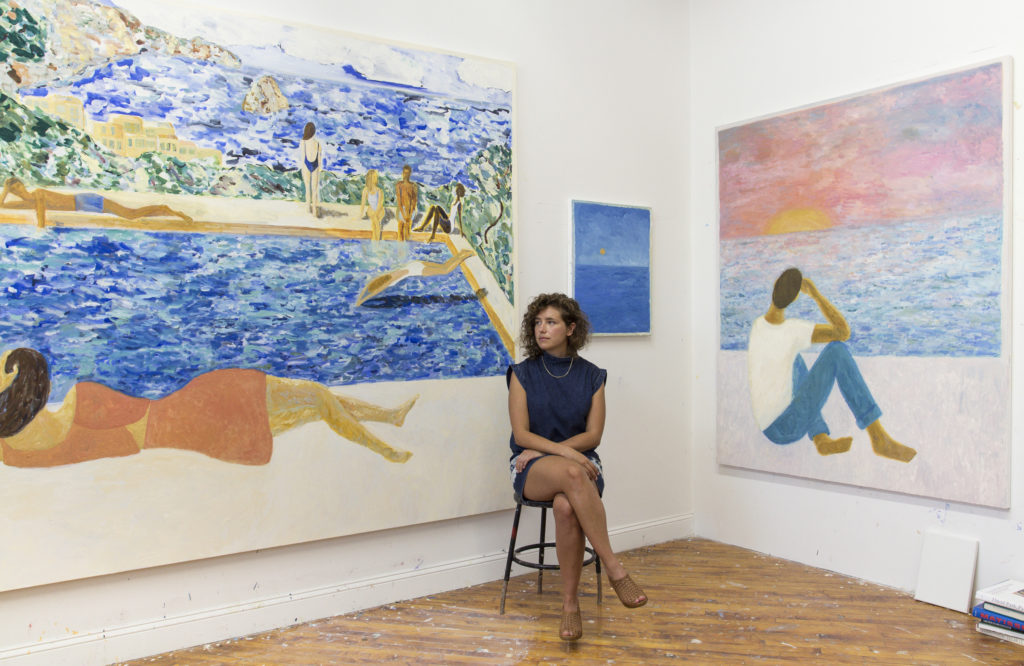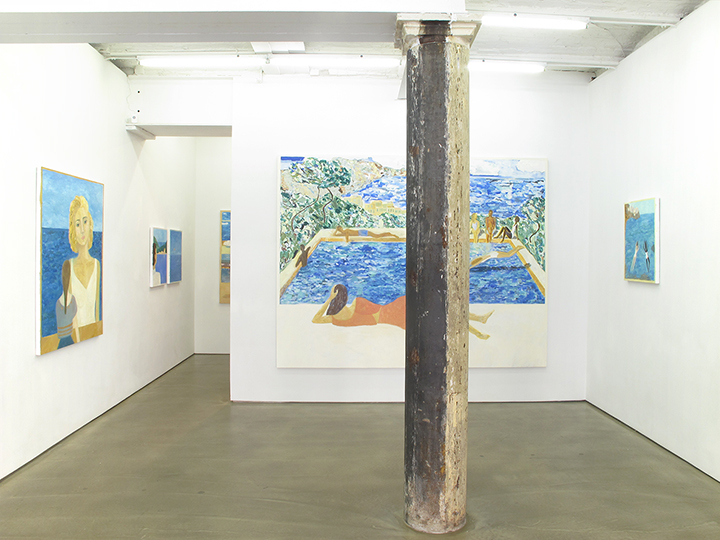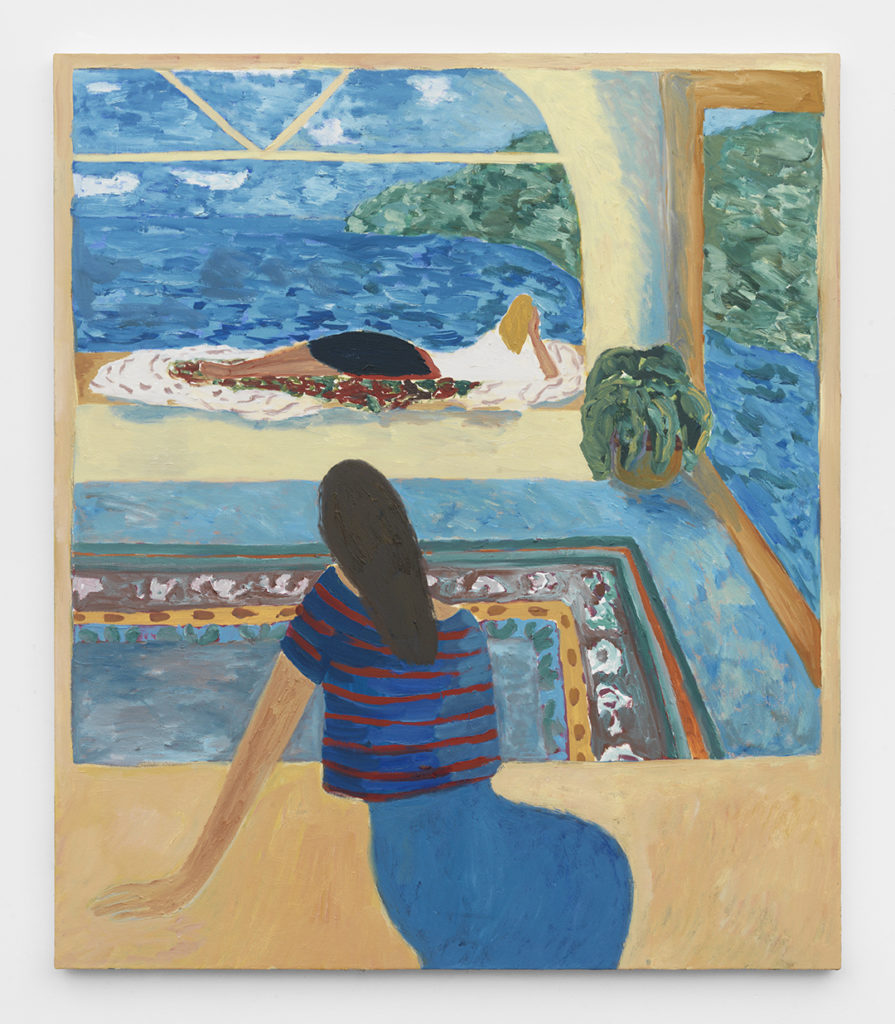“Jessie Edelman on Being a Painter in the Digital Media Age”
by Henri Neuendorf
September 8, 2016

Stepping into Jessie Edelman’s Brooklyn studio is like being transported to a different era. Her paintings hanging and leaning against the walls depict contemplative figures gazing into landscapes, reflecting an exciting contemporary interpretation of 19th and 20th century painting.
Edelman applies paint to the canvas in vivid, textured brushstrokes and evidence of her technical approach is everywhere—it’s tough to find a patch of floor space or piece of furniture that hasn’t succumbed to a splatter of oil paint.
Taking inspiration from Caspar David Friedrich’s melancholic figuratism, the Impressionist’s painting-within-a-painting perspective, and Elizabeth Peyton’s brushy, airy technique, Edelman seamlessly blends influences from across different periods in her work which is laden with art historical references to past and present.
Although the Milwaukee-born artist’s work appears deeply nostalgic at first—her process is decidedly contemporary. For example Edelman admits to using Instagram and her friend’s online photographs as one of her sources of inspiration, creating a fascinating tension between past and present, whilst adding a deeply intimate and personal facet to her paintings.
Ahead of her first solo exhibition at New York’s Denny Gallery, artnet News visited Edelman in her Bushwick studio to speak about the show, her work, and being a painter in the digital media age.
 Installation view, Jessie Edelman: Stills from “The End of Summer” at Denny Gallery.
Installation view, Jessie Edelman: Stills from “The End of Summer” at Denny Gallery.
What are some of your artistic influences?
My early influences came from going to the Art Institute of Chicago and seeing the Impressionists and Post-Impressionists painters there. So I really love [Pierre] Bonnard, [Claude] Monet, [Paul] Cézanne, [Vincent] van Gogh, [Henri] Matisse… Going to the museum and seeing those paintings, I really try to capture them in my mind and hold on to them, and so those early artistic influences are definitely still with me today. But I also like to think about some contemporary painters like Elizabeth Peyton, Ann Craven, and Nicole Eisenman are all influences on me. I like to see what other painters that are alive today are doing.
 Jessie Edelman Still (2016).
Jessie Edelman Still (2016).
What is it about figuration that is so appealing to you?
I like thinking about the figure because I’m interested in a new humanism or a new sincerity and a way of showing feeling and expression in painting. I think by having the figures in my work, I’m able to do that. In my paintings, the figures are often looking, or thinking, or contemplating and mirroring what the person that’s looking at my work is doing. So I’m thinking about a voyeur or someone who’s having some experience of looking and thinking.
But when I think about painting, I kind of think about the possibilities of what a painting can do. So I’m thinking about the material of paint, and that’s why my work is so painterly. I want it to have that human touch to it, and that texture of paint so it doesn’t feel like it could’ve be made by a machine. I want it to look like it was made by an individual artist.
And then I’m also interested in the painting as an object, and its function in the space that it’s existing; whether that’s a gallery, a studio, a museum, or a home. And so that’s where the framing device comes into play, so it always sort of feels like a painting of a painting, or a painting of another window space, or even a virtual space or screen space. And then I like to think about the painting as a fiction and a window. I’m trying to stretch what a painting can do.
 Jessie Edelman Windows (2016).
Jessie Edelman Windows (2016).
The depiction of figures from the rear is a recurring perspective in your work. Why?
When I think about space I actually think in a more abstract way in terms of color relationships. I’m thinking more about Josef Albers or [Mark] Rothko and the flatness of space. And so space get’s pushed back because of the color relationship versus a perspectival relationship. So my paintings end up being really flat. The paintings sometimes feel as if they could be tipping forward. I feel like the pool in that painting could be tipping forward or falling back at the same time.
To what extent is your work reflective of the transience and impermanence of contemporary image culture, as a result of the prevalence of social media and Instagram?
I feel like during the Impressionist period, painters were thinking about what does it mean to make a painting in the age of the camera? And I feel like today, a really important question is how do you make a painting in the age of digital media? And so I’m really interested in our experience of scrolling and cycling through images, and swiping through images. Everybody is carrying around handheld devices so how do I make a painting to reflect that. I’m interested in having a screen and the figure in my painting function as a sort of flaneur, a voyeur.
Ultimately, I’m interested in the figure being present and engaging and not being checked out, because I feel like devices and phones really check people out of reality. But I think there’s a type of oscillation in my paintings between staring, being bored, but also a sense of engagement. But for references for my work I’m definitely looking at photos on Instagram and other people’s vacations.
It’s an interesting contrast that you’re influenced by movements from the past, but are sourcing ideas from a very contemporary medium.
As a prompt for this series of paintings for this show, I was thinking about where I wanted to be this summer and where I would like to go. But I’m here in my studio looking at other people’s vacations and where they’re going. Some of the images for these paintings came from other people’s and my friend’s photographs, which I think is interesting.
I was also kind of imagining that if I would make a movie these would all be stills from scenes from the movie in an imaginary, utopian place. In fact the Greek word “utopia” means nowhere, and I like that idea of imagining where I would want to be.
I like to think of painting as an object of desire, something that we want and covet. When I was a child going to the museum, I wanted these paintings but I couldn’t take them with me. I could only capture the images in my mind and try to hold on to them. And so I’m trying to create in my paintings this world that I would want to be in, or this movie that I would want to be in.
And then there’s this disconnect that we have, people who are active on social media are curating their own lives and their own experiences but they’re imagining their fiction version of what their life actually is and there’s the disconnect of other people looking at those curated images or stylized images.
 Jessie Edelman Sunset (2016)
Jessie Edelman Sunset (2016)
Can you address the theme of melancholia in your work?
I feel like that feeling often comes out in my work. I’m interested in a figure who’s in a state of solitude and contemplation and looking at the world around them. I feel like it’s a certain archetype and I’m thinking of Caspar David Friedrich’s paintings of a lone figure looking out at a landscape and that figure having a sublime experience.
I’m also interested in Andrew Wyeth’s painting Christina’s World (1948) of this woman looking back at this house. Or that idea of the flaneur of Baudelaire’s poetry, which often shows this lone figure wandering the streets feeling disconnected from all the people in the city. And that’s the type of feeling I’m trying to elicit in my work—that the figures are often separated from that action or the landscape in front of them.
